by Ruffin Prevost
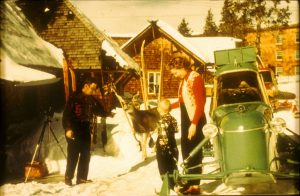 Getting around Yellowstone National Park in the winter has never been easy. Over the past century, visitors and workers have relied on an array of evolving and sometimes dubious technologies, ranging from plane fuselages mounted on skis to a tractor outfitted with two pontoon-sized augers. Even with modern snowcoaches and snowmobiles, winter travel in Yellowstone still requires what some park veterans describe as “an enhanced sense of adventure.”
Getting around Yellowstone National Park in the winter has never been easy. Over the past century, visitors and workers have relied on an array of evolving and sometimes dubious technologies, ranging from plane fuselages mounted on skis to a tractor outfitted with two pontoon-sized augers. Even with modern snowcoaches and snowmobiles, winter travel in Yellowstone still requires what some park veterans describe as “an enhanced sense of adventure.”
But the extra effort required to navigate Yellowstone’s snowy landscape is rewarded with a park blanketed in dazzling white, offering a quieter pace, peaceful solitude, and splendid isolation. For longtime area resident Rick Hoeninghausen, an overnight winter trip to Old Faithful brings opportunities that summer can’t offer.
Day visitors are clearing out by mid-afternoon, and only a few hundred people are around the entire Upper Geyser Basin by dark. “You can go out on the boardwalk and take in a geyser eruption by moonlight. It’s a stunning show,” said Hoeninghausen, vice president of marketing in Yellowstone for Xanterra Travel Collection, the park’s lodging concessioner.
The dark skies over the park mean “the stars put on an amazing show on a moonless night,” he said. “Sometimes you can see your starlight shadow on the snow, which I think is just incredible.” Cross-country skiing and snowshoeing continue to grow in popularity, he said, with trails to destinations like Lone Star Geyser offering a singular winter experience in the park.
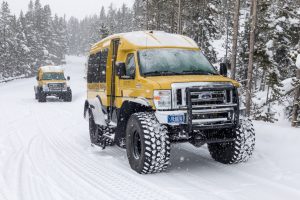
Hoeninghausen said winter travel in Yellowstone over the last quarter-century has moved away from adrenaline-fueled snowmobile trips to more contemplative outings focused on learning about the park’s geology and ecology. Using low-pressure tires, instead of tracks or treads, has made snowcoaches quieter, more fuel-efficient, and comfortable, he said.
Comfort was hardly a consideration for the park’s earliest regular winter travelers, said Yellowstone National Park Historian Alicia Murphy. U.S. Army soldiers used giant wooden slab-style skis to patrol for poachers. They employed a single long pole, mainly to stop themselves while sliding downhill. “I don’t know how anyone survived that,” Murphy said of the soldiers’ regular patrols between backcountry cabins spread across the park. “Those guys were really tough.”
For decades, skis were the only way to move around the park in winter. In April 1903, President Theodore Roosevelt visited Yellowstone, taking a special excursion by horse-drawn sleigh to Old Faithful and Canyon, said Leslie Quinn, interpretive specialist for Xanterra.
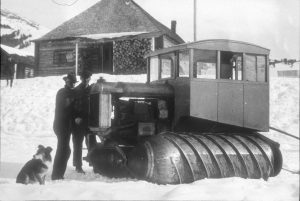 The first motorized winter vehicle in Yellowstone “was an oddball item called a screw tractor,” Quinn said. The vehicle was essentially a tractor mounted on two cylindrical tubes with raised spirals, which pulled it across the snow while “floating” over drifts. The vehicle shuttled between Roosevelt Lodge and Cooke City, Montana, in the mid-1920s, Quinn said.
The first motorized winter vehicle in Yellowstone “was an oddball item called a screw tractor,” Quinn said. The vehicle was essentially a tractor mounted on two cylindrical tubes with raised spirals, which pulled it across the snow while “floating” over drifts. The vehicle shuttled between Roosevelt Lodge and Cooke City, Montana, in the mid-1920s, Quinn said.
Another odd vehicle used by park workers was the Weasel, a bit of military surplus left over from World War II. A tracked vehicle designed for snow warfare, the Weasel was like a small open-air tank without a gun. Quinn said the Weasel was instrumental in the rescue of the lone survivor of a May 1963 B-47 bomber crash near Shoshone Lake.
Snow planes were another novel winter vehicle. Walt Stuart, a West Yellowstone, Montana, mechanic, built three snow planes that were the first used in the park. Used elsewhere since the 1930s, snow planes were enclosed cockpits on skis, with a pusher propeller mounted at the rear. In 1949, Stuart’s three snow planes took a total of 35 people through the park on 19 trips.
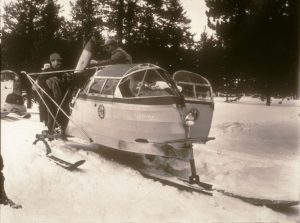 “They were phenomenally, wonderfully dangerous things,” Quinn said. The unguarded propeller was at ground height, and the crafts were prone to tipping over during sharp turns.
“They were phenomenally, wonderfully dangerous things,” Quinn said. The unguarded propeller was at ground height, and the crafts were prone to tipping over during sharp turns.
Snow planes were short-lived in the park, with snowcoaches arriving on the scene in 1955 and snowmobiles entering use in 1963. By the 1970s, snowmobiles were the dominant mode of winter travel in Yellowstone.
Today the road from Mammoth to Cooke City is plowed, offering visitors in autos a chance to watch wolves and other wildlife meet the challenges of winter along the park’s northern range.
The National Park Service continues to require the use of best-available technology for snowcoaches and snowmobiles to ensure cleaner air and quieter winter soundscapes, Historian Murphy said. While park officials would like to see an electric snowmobile developed, the practical implementation of that technology remains out of reach, she said. But such a vehicle could eventually help set a new standard for other parks, just as a group of Army regulars helped set a standard in 1894 when they caught a notorious poacher.
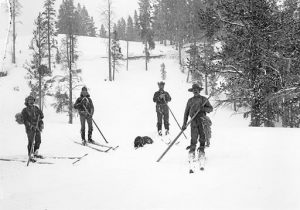 Soldiers patrolling along Pelican Creek during a March snowstorm captured Edgar Howell, who was skinning several bison he had just killed. Howell bragged in front of a reporter as he was being jailed that his punishment would be limited only to expulsion from the park and forfeiting his gear. The subsequent publicity and outrage forced Congress to pass the Lacey Act, a sweeping law protecting wildlife on federal lands.
Soldiers patrolling along Pelican Creek during a March snowstorm captured Edgar Howell, who was skinning several bison he had just killed. Howell bragged in front of a reporter as he was being jailed that his punishment would be limited only to expulsion from the park and forfeiting his gear. The subsequent publicity and outrage forced Congress to pass the Lacey Act, a sweeping law protecting wildlife on federal lands.
Before then, weak rules and policies against poaching made it tough to go after offenders, Murphy said. “So that new law forever changed how we protect Yellowstone and any federal preserve,” she said, “all thanks to that winter activity by those tough soldiers on skis.”
This article was originally published in the Winter 2018 issue of Yellowstone Quarterly.
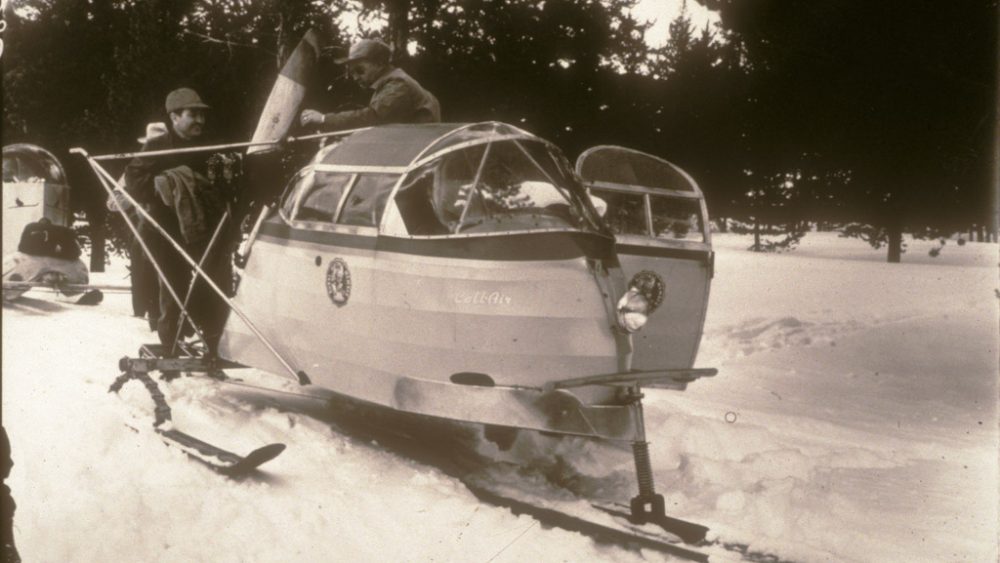
Comments are closed.